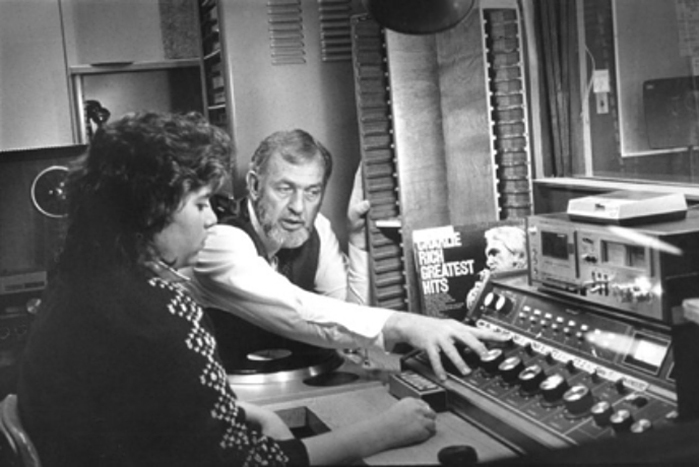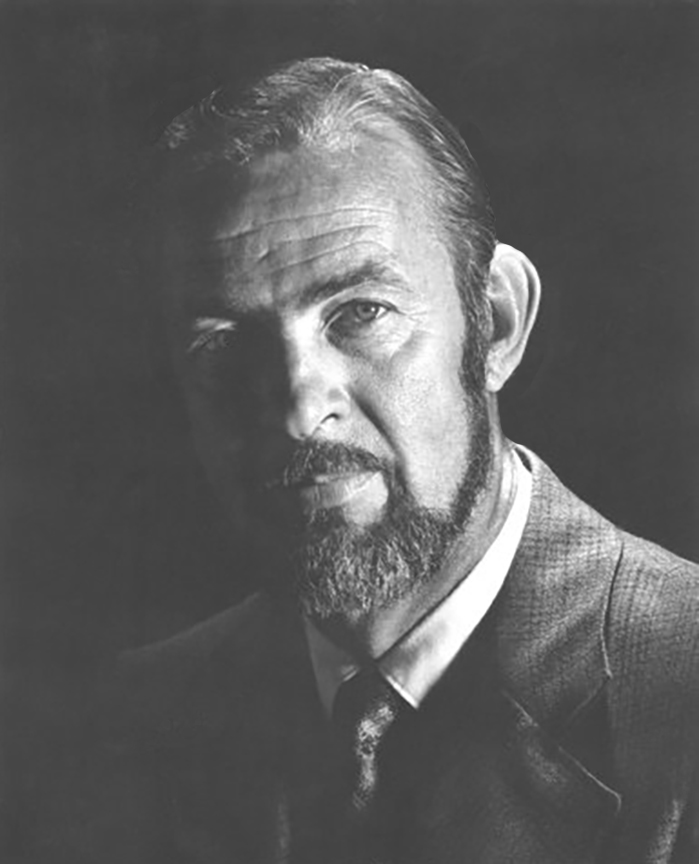Dan Odum
CSM broadcast instructor
Former station manager, KCSM-FM
“I recall driving up 92 when it was a two-lane road. I saw white buildings on the top of the hill and thought, ‘It’s certainly not them, because CSM is a junior college and junior colleges do not look like that.’”
– Broadcast instructor Dan Odum on his CSM job interview
Dan Odum joined College of San Mateo in 1964 to run KCSM-FM and to teach radio broadcasting at its new College Heights campus. In his 27 years at CSM, Odum launched some of the Bay Area’s top radio talents in KCSM’s studios.
A fellow San Diego State alumnus, Doug Montgomery, recruited Odum from a classical radio station in San Diego. While KCSM 91.1 FM began in 1953 on the Baldwin campus, Montgomery had only just been hired to launch the new television side.
“I could see several buildings still being built in July 1964,” Odum told Rick Zanardi, one of his first students, in a 2018 oral history. “Carl Ward, a vice-president of the college, said, ‘The only caveat is that we need you here in two weeks.’ In that time, I had to develop a radio training program.”
Odum had been heavily involved in radio production and station operations, precisely the boots-on-ground matters that Jacob Wiens, head of CSM’s broadcast program, wanted students to learn.
“Most of the kids wanted to be DJs,” Odum said. “There’s more to it than that.” He devised a plan to weed students out who weren’t serious.
“I used an Arch Oboler radio play called ‘The Cat Wife.’ It was really weird, with a lot of side effects. I’d close the curtains, turn off the lights, bring up the sound and play this to the students. It involved the wife turning into a cat ...
“When it was over, I handed out a questionnaire: What was the color of the wife’s hair? What were her eyes like? Where was the telephone located? None of that was [specified] in the program.
“Those of the kids who had imagination would say, ‘Her hair was jet black. Her lips were purple ...’ Some said, ‘That wasn’t in there.’ ... And I told them, ‘You have two weeks to find another class.’
“The first requirement was that the kids had to have imagination. Old-time radio depended on that.”
Unlike most beginning broadcasters, CSM graduates didn’t have to move to small towns to pay their dues before moving up. They were immediately snapped up by stations in San Francisco.
“The reason they were accepted was that they came with a knowledge of the requirements to be on the air,” Odum said. “And a knowledge that the clock is next to God.
“You meet the network on the hour, not 30 seconds after the hour. The disciplining was extremely important to me.
“It was mandatory, in my estimation, to put [students] on where the red light would come on and you point a finger and say, ‘You’re on the air,’ and have them know that there are people listening to them.”
At home, Odum kept a receiver tuned to 91.1 FM day and night.
“He could tell if the student was distorting or the music was too loud or the mix was bad,” Zanardi remembered. “You were always in the classroom.”



‘It ain’t a HE’
Conversely, Odum worked hard for his top students. Alumna Bonnie Chastain ’72, as he recalled, was “one of the ones we liked most to remember because she did so much for the women in broadcasting.”
A manager at KCBS in San Francisco had told Odum “that if I had a student who was really good, don’t send HIM anyplace until I have a chance to talk to HIM.
“Well, SHE had really proven herself. [The manager] said, ‘Does HE have a first-class license?’ and I said, ‘Well, it ain’t a HE.’
As CBS’s first female engineer and later a news director, Chastain (1938-1988) paved the way for other women in news and became an icon for 1970s women seeking new horizons. She married morning-drive news colleague Dave McElhatton, and their storied work and love partnership ended all too soon with Chastain’s early death from cancer.
The voice of the Giants
Future Major League Baseball announcer Jon Miller came to CSM in 1969, while he was still in high school in Hayward. “It was Telecom 52a, the intro class,” Odum said. “I don’t know how he got in, but he did. I was immediately aware he had special talent.
“He had spent a lot of time in the nosebleed section of the Oakland Oaks stadium. He would take a reel-to-reel battery-operated machine with a mic and he would call the game: ‘There’s a long fly ball hit deep into center field’ ... hhhhhhh ... He’d make a lot of noises into the microphone to duplicate the sound.
“We said, ‘OK, but we have an audition.’ It was a 16mm game film of the 49ers in 1963. You know, the game films don’t cover anything but the plays themselves. I told him, ‘I want you to call this game. You have to know the players, name the players, name the calls.’ And he did it. He blew me away. He did it with such authority that it sounded like he was there.”
All future sportscasters cut their teeth on Bulldog athletics. Each year, Dodge dealer Jim Burney lent KCSM a new van to fit out for remotes.
“Miller had a friend ... who came here, and the two of them would sit in the van in the second seat ... and would do football or baseball trivia. One would ask the other, ‘Who was playing second base in the third game of the 1948 World Series when Joe DiMaggio hit that long home run? And both of these guys had all the answers. They had encyclopedic minds.”
After a short stint at a Santa Rosa TV station, Miller was picked up by the Oakland As in 1973 to do color. He went to Texas, the Minnesota Twins, the Baltimore Orioles, then in 1997 back home to do play-by-play for the Giants, where he remains today.
Odum maintained his passion for classical music, enriching the airwaves at both KCSM and the wider Bay Area. While at CSM, he worked nine years as weekend relief as a classical radio announcer for KKHI. Retiring officially in 1989, he returned to CSM for two semesters to teach as an emeritus and then ran a video production business for 20 years.
He recalled as a favorite CSM experience a field trip he engineered to the recording industry in Hollywood in 1964-65. Through an airline contact, he finagled round-trip airfare at $13 a head.
“We had seven cars waiting for us. We had 42 kids. We went to NBC-TV, ABC, Capitol Records. We stood in the control room as the Capitol Symphony played. ... We learned how to mic up and mix a symphony orchestra. We went to the pressing plant where they pressed LPs.
“And we got down and back without losing a single kid.”

